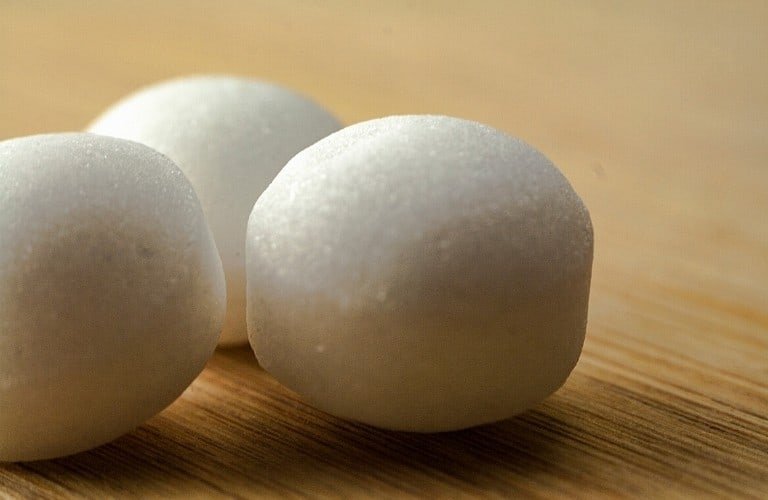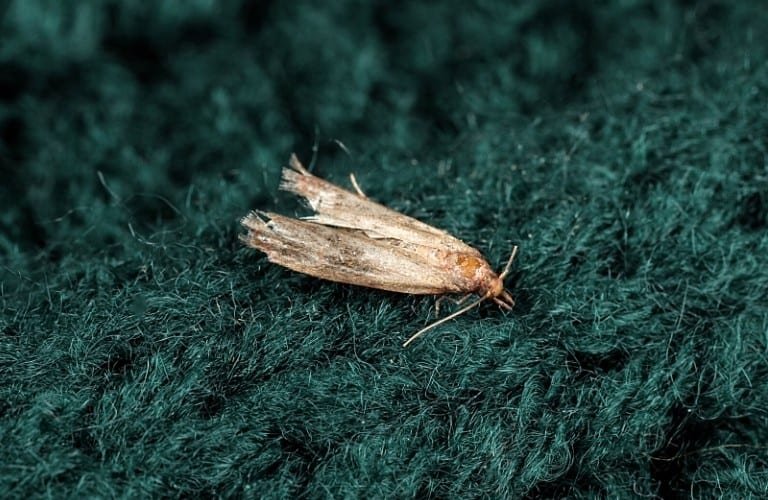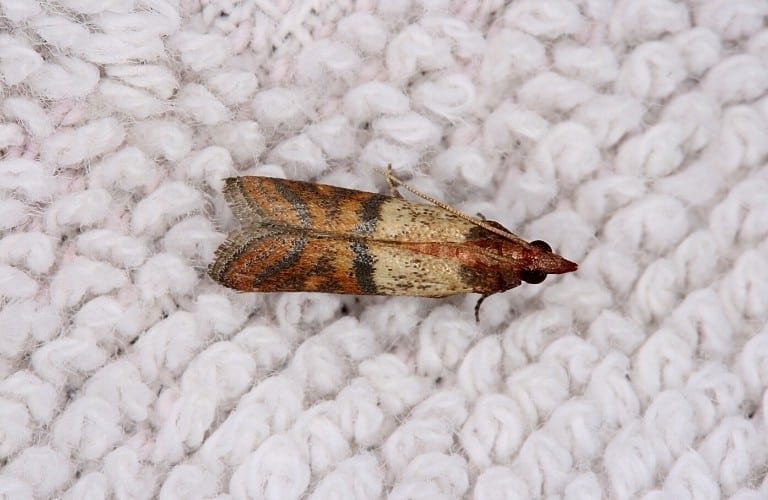Mothballs may remind you of visiting your grandparents’ house when you were young. They’re a strong source of nostalgia for many people.
These days, you hardly see them around any more, thanks to the discovery of just how toxic they are to people, pets, and the environment.
What are some alternatives to mothballs? Lavender, cedar, citronella, and camphor can be used safely indoors to repel moths. Sticky traps with pheromones will help eliminate existing moth populations. Outdoors, use Btk to fight moths, scatter cedar chips to repel moths and rodents, or use rodent traps.
There are a ton of natural alternatives to mothballs that you can use that will cause little to no danger to you and your loved ones.
Continue reading to learn what options you have.
Be sure you’re not missing out on key prevention tips and elimination strategies. Our article “How To Get Rid of Moths” covers it all!
Best Practices for Preventing an Infestation
It’s important to know what a moth looks like so you can make sure you’re fighting against the right bug.
Moths are similar to butterflies, but they have a couple of distinct features: feathery antennae and attached wings.
The front and back wings are connected to each other, but a butterfly’s wings are detached.
Common house moths are typically brown, black, gray, and white and measure about 1 inch in length.
Why are they so commonly found indoors? Find the answer here.
Clothes moths are the ones that you find in bedrooms and closets that will chew up your clothing.
Pantry moths can be found in your kitchen in cardboard boxes, eating packaged foods, and laying eggs in flour and cornstarch.
See what else these destructive winged pests will eat in this article.
Clothes Moth
Pantry Moth
House moths are easy to tell apart from butterflies, but if you see moths in the wild, it may take a moment to figure out which is which.
Basic Guidelines
Preventing moths is easy and doesn’t require much special treatment. It’s as simple as storing items properly, dusting, and removing water.
Store Clothing in Containers
Prevent moths by storing your winter clothing in airtight containers (these are perfect).
Moths prefer natural fibers like wool and fur over synthetic ones, so it’s especially important to store those away safely when you’re not using them.
No products found.
No products found.
Brush natural fibers with a fine-toothed comb before you store them to remove any eggs or larvae that were recently deposited.
This will prevent them from growing and chewing up your clothing while trapped with your things.
Don’t assume that trapped larvae and moths will die quickly if trapped inside storage containers.
They can actually survive quite a long time (we explain here) and cause much damage in the meantime.
Remove Dust in Your Home
Moths are attracted to dust which is one of the reasons they may be drawn into your home.
Give your home a thorough cleaning at least once a week to remove dust.
Use a duster to clean crown molding, baseboards, and surfaces. Sweep, mop, or vacuum floors, carpets, and rugs.
Unused guest bedrooms may need to have the bedding washed semi-frequently.
Remove Moisture
Moisture is another thing that draws moths in.
If you have a part of the home that is frequently humid or wet, you may need to repair a leaking pipe or crack in the home.
You can use a dehumidifier in bathrooms and basements (look for one with an auto on/off feature like affordable option) or replace carpets with tile to prevent moisture from puddling up and lingering around.
No products found.
No products found.
Mothball Alternatives – What to Look For
Mothballs are used to repel and kill moths, but mothballs contain toxic chemicals that are unsafe for the environment, people, and pets.
Some people use them outside for rodent control, but it’s actually illegal to do this because it’s not listed on the label as an approved way to use them.
Types of Mothball Alternatives
There are several types of alternatives to mothballs that you can use that aren’t harmful to the environment or your loved ones:
- Repellents: Essential oils and other natural ingredients can be used to repel moths. Cedar, lavender, and citronella are the most commonly used for this purpose.
- Moth killer: Sticky traps are a simple way to kill moths. Most of them don’t contain any chemicals, so they’re safe to use in your home.
- Rodent repellent: Mothballs were commonly used to keep rodents out of yards. Instead of mothballs, you can use cedar chips to keep rodents away since they don’t like the smell.
Effectiveness
Admittedly, many alternatives aren’t as effective as mothballs. But, they’re worth using because they’re far less harmful to use in your home.
Breathing in the toxins released by mothballs can be lethal, especially if a lot of them are breathed in.
The natural alternatives we mention cause little to no issues when exposure occurs.
Repellents like lavender and cedar will only repel the moths; they won’t kill them.
So, putting lavender in a container with your clothing won’t be useful if the moths don’t have a way out.
Sticky traps are effective at getting rid of adult moths, but they won’t kill the eggs or larvae, which are really what you need to kill to prevent further damage to your belongings.
Safe for Use Around People and Pets
Most natural alternatives are completely safe to use in your home.
Essential oils, however, can be skin irritants if they aren’t properly diluted and may burn your eyes.
Cedar can be poisonous to animals when consumed, so if your pet will eat anything, you’ll need to be careful when using it or avoid using it altogether.
Camphor is another natural item that can be harmful when ingested.
Natural doesn’t mean harmless.
Always read the directions on the package of anything you use to control pests to make sure you use it correctly to keep you and your animals safe.
Ease of Use
Many of the alternatives are super easy to use, although most of them aren’t reusable. However, they’re usually inexpensive and are easy to replace.
Reusable
Sachet bags and candle holders can be refilled with new products as needed.
The container that a candle comes in may not be reusable; check the label to make sure it’s safe to repurpose.
Humane rodent traps are reusable after you’ve released the animal back into the wild. You’ll need to check the traps frequently and refill it with any bait you’re using.
Disposable
Sticky traps can be used until they’re filled with moths, but then they’ll have to be thrown away.
Cedar is another thing that won’t last forever.
Once the oils in it have dried out and you can no longer smell it, you’ll need to dispose of it and replace it.
If you use natural wood that didn’t have chemicals added to it, you can compost it or recycle it to be repurposed.
Find more moth information and additional elimination methods in our other moth articles. Click here to access them all.
Best Indoor Mothball Alternatives
Mothballs are mostly used indoors, so it’s important to use an alternative that’s safe. Luckily, there are plenty of options to choose from.
Let’s take a look at some of them.
TINOLA Clothes Moth Traps
No products found.
No products found.
These clothes moth traps don’t have any toxic chemicals, but they do have moth pheromones to attract moths.
You can place them in a container with your clothing or hang them on hangers, and the moths will soon leave the clothing they’re chewing on.
The trap is good for up to three months, but it may fill up sooner depending on the size of your moth problem.
This trap is intended for clothes moths, so you shouldn’t try to use it for pantry moths. The pantry moths won’t be attracted to the pheromones used.
Pros:
- Lasts for up to three months.
- Doesn’t contain chemicals.
- Can hang or be placed in a container.
Cons:
- Won’t attract every type of moth.
Cedar Sense Cedar Rings
No products found.
No products found.
These cedar rings are completely natural and will hold their scent for a long time for continual protection.
You can hang them on clothing hangers for convenience and slide them into other parts of the closet as needed.
Cedar won’t kill moths, so this product won’t be an effective removal method inside airtight containers.
Keep these away from pets who will chew on anything since cedar can be poisonous when eaten.
Pros:
- Can be used on hangers.
- Long-lasting, strong scent.
- Only wood; no chemicals.
Cons:
- Can’t kill moths.
- Harmful to animals if consumed.
Gya Labs Lavender Essential Oil
No products found.
No products found.
Lavender is a common way to repel moths. This lavender oil is pure organic lavender and doesn’t have anything added to it.
You can add a few drops to a spray bottle and spray your belongings to repel moths, or you can add a few drops to cotton balls and leave the cotton in your closet.
An oil diffuser will work too since it’s the smell of it that moths don’t like.
If you want to apply the oil to your skin while you’re outside, be sure to dilute it with a carrier oil since it can irritate the skin by itself.
Pros:
- Pure lavender oil; no additives.
- Organic.
- Can be used in many ways.
Cons:
- May be a skin irritant.
Armour Shell Lavender and Cedar Sachet Bags
No products found.
No products found.
Sachet bags are a great way to repel moths. These bags have either lavender buds or cedar shavings in them and produce a potent but enjoyable scent.
Place them wherever you have moths and they’ll vacate the area soon.
As with other lavender and cedar products, they won’t kill moths but will only deter them from hanging around.
Once they lose their smell, you’ll need to replace them with new ones.
Pros:
- Strong scents.
- Safe to use around children and pets.
- Contents won’t fall out of bags.
Cons:
- Won’t kill moths.
Soul Sticks Camphor Tablets
No products found.
No products found.
Camphor can be used to repel moths and many other insects. You can burn it as a candle, melt it in a candle warmer, or put pieces of it in sachet bags.
The scent will keep moths away, so you can utilize it in whichever way is most convenient for you.
Camphor will create smoke when it’s burned, so it may be unpleasant to use inside your home.
It’s also not safe to consume, so keep it out of reach from curious children and pets.
Camphor is also used for medicinal purposes, so be sure to read the label to make sure you use it in a safe way.
Pros:
- Can be burned to repel moths.
- Can be used in sachets.
- Minty scent.
Cons:
- Creates smoke when burned.
- Not safe for children and pets.
Best Outdoor Mothball Alternatives
Mothballs are sometimes used outdoors, although it’s illegal to do so. People use them in this way to keep moths and rodents away from their homes.
We’ve listed some alternative options for both moth and rodent control so you don’t have to risk getting in trouble by using mothballs incorrectly.
Monterey Bacillus Thuringiensis
No products found.
No products found.
Bacillus thuringiensis kurstaki, or Btk, sounds like a harmful chemical, but it’s actually a naturally occurring bacteria that can be found in soil and on plants.
This bacteria won’t kill animals or beneficial insects, but it will kill moths in their caterpillar stage.
You’ll need to know where the moths live and lay eggs in order for this to be effective.
Moths usually live in trees and moist areas, so if you haven’t spotted them yourself, try these areas first.
Pros:
- No chemicals added.
- Kills moths before their adult stage.
- Won’t kill beneficial bugs or animals.
Cons:
- You’ll need to know where moths lay their eggs.
Four Winds Trading Natural Cedar Shavings
No products found.
No products found.
The scent of cedar will not only repel moths but rodents too.
If you need to get rid of squirrels, chipmunks, or mice, spread cedar shavings throughout your flowerbeds and around trees to deter them from climbing up your house and trees.
Wood shavings are an excellent mulch for plants and they’ll eventually decompose and turn into great compost.
Cedar is harmful when consumed, so keep an eye on kids and pets when you’re outside. Don’t leave them unattended if you think they’ll try to eat it.
Pros:
- Repels insects and rodents.
- Excellent mulch for plants.
- Safe for kids.
Cons:
- Poisonous to animals when consumed.
Coleman 70+ Hour Citronella Candle Lantern
No products found.
No products found.
This citronella candle lantern promises 70 hours or more of burn time, which is guaranteed to last you for several evenings on the patio.
It’ll repel moths, mosquitoes, and many other picky bugs that can’t stand the smell.
Once the candle is burned up, you can replace it and use the lantern part again.
The downside of this method is that it’s only effective while you’re using it, so it won’t serve as a long term solution.
Pros:
- About 70 hours of burn time.
- Repels moths, mosquitoes, and many other insects.
- Can replace the candle once it’s burned.
Cons:
- Only effective when it’s burning.
Yellow LED Bug Light Bulb
No products found.
No products found.
Moths and other insects are attracted to white lights more than they are to yellow lights.
So, if you always have moths at your door because of your porch light, try switching to a yellow bulb.
It won’t make them all go away, but there will be fewer of them fluttering around your door.
These bulbs are an inexpensive way to cut down on the number of moths getting inside, and the bulbs are super easy to install.
Many people use yellow lights outside, so it won’t seem out of place.
Pros:
- Effortless way to get rid of moths.
- Inexpensive solution.
- Yellow light won’t seem out of place.
Cons:
- May not fit all light fixtures.
AB Traps Humane Animal Trap
No products found.
No products found.
Instead of using toxic mothballs to keep rodents out of your yard, try using a humane trap.
This trap is a catch-and-release trap, so you can easily release the animal into the wild after you’ve trapped it.
Place bait inside the trap to entice pests to enter.
It’s not a permanent solution and you will have to worry about checking the trap frequently to let the animal out.
However, it’s a better solution than using mothballs illegally, and these traps won’t cause any damage to water or soil.
Pros:
- Humane way to catch rodents.
- Easy to let rodents out.
- Small enough to be discreet.
Cons:
- Not a permanent solution.
Frequently Asked Questions
Is It Illegal to Put Mothballs in Your Yard?
It is illegal to put mothballs in your yard because they contain toxic chemicals that are used to kill moths.
Mothballs are regulated by the Environmental Protection Agency, which means that if they’re used in a way that the label doesn’t say you can use them, it’s considered illegal and dangerous.
Mothballs turn from a solid to a gas, which is how toxins are released into the air. This can hurt anyone who breathes it in, including animals.
The toxins can also be released into soil and water, which will harm the environment.
Can I Put Mothballs Around My House?
You can’t put mothballs around your home because it’s dangerous and illegal. The toxins that are released by mothballs can harm people, animals, and the environment.
Some people may put mothballs outside to kill rodents, but they’re putting neighborhood pets and children in danger since curious critters and kids like to put things in their mouths.
Final Thoughts
Mothballs were once used by many people, but they have fallen out of favor since they’ve been proven to be incredibly toxic.
There are many safe alternatives out there you can use, so give some of them a try before you revert back to an old method that can harm you.
Source:





